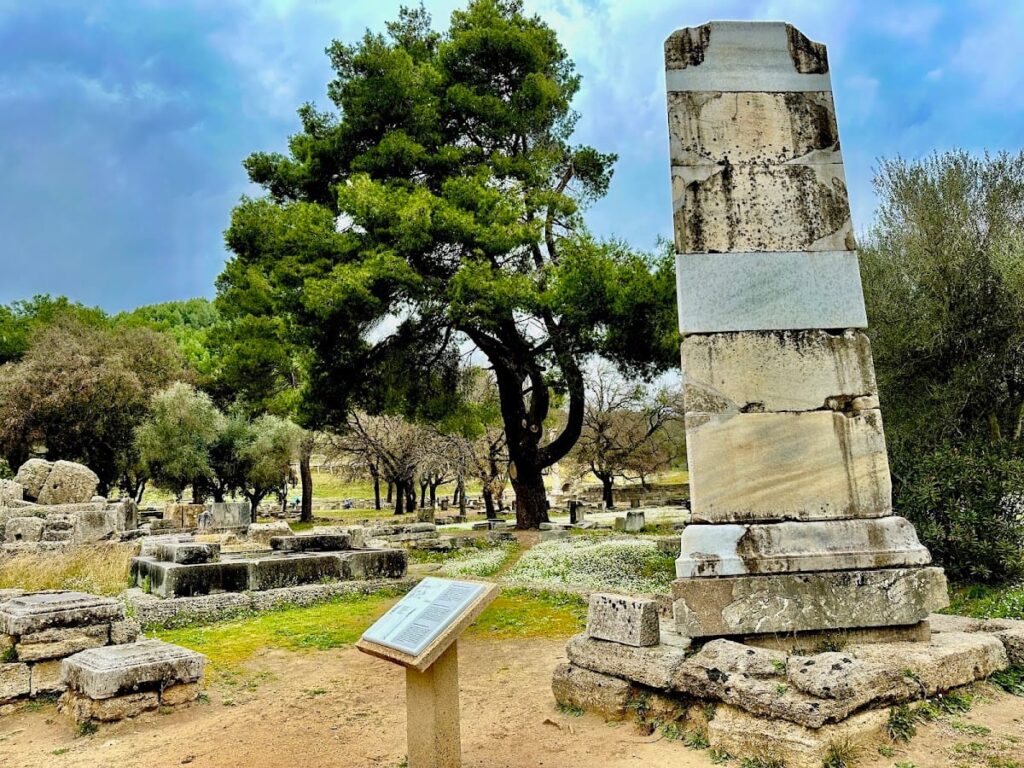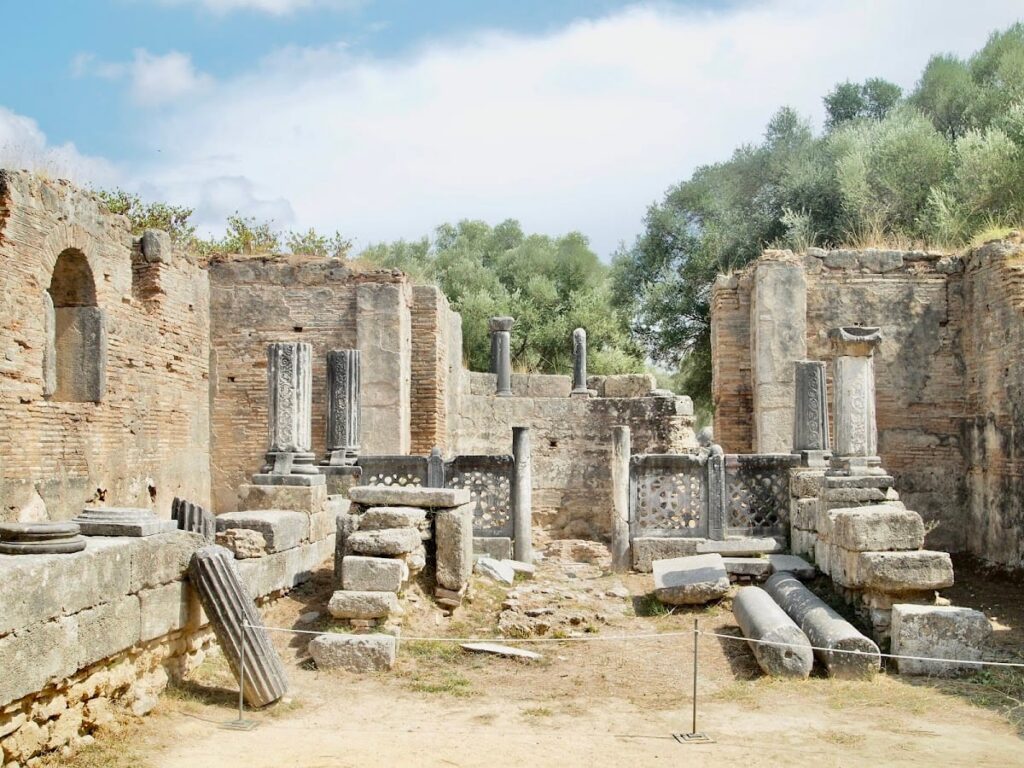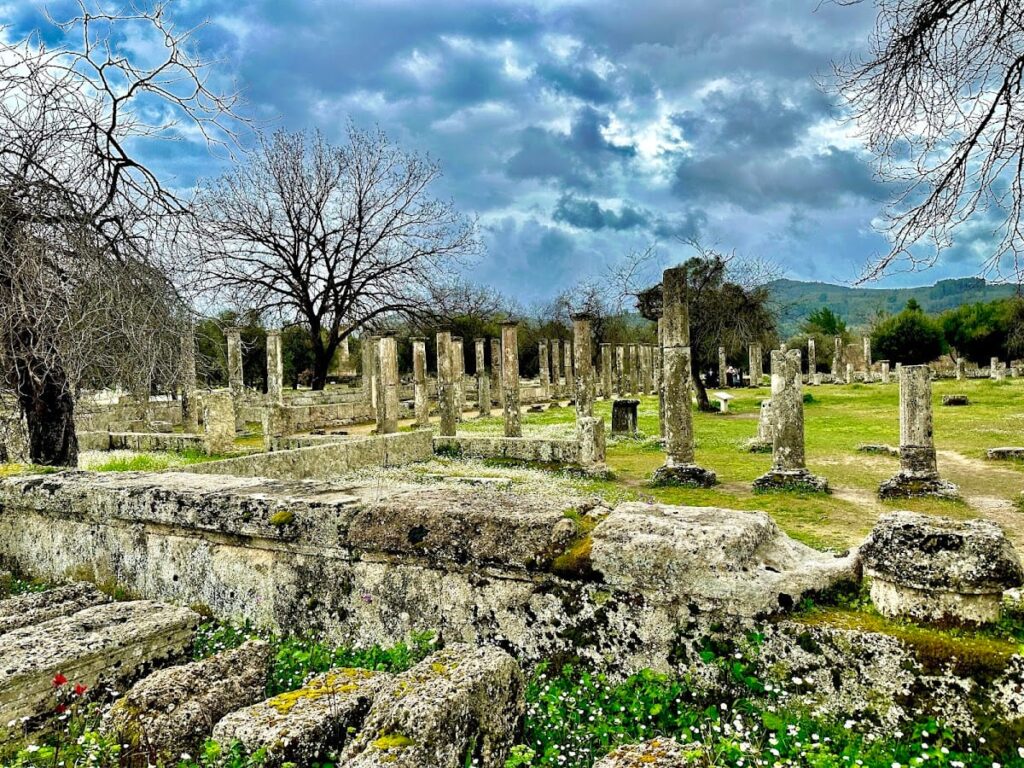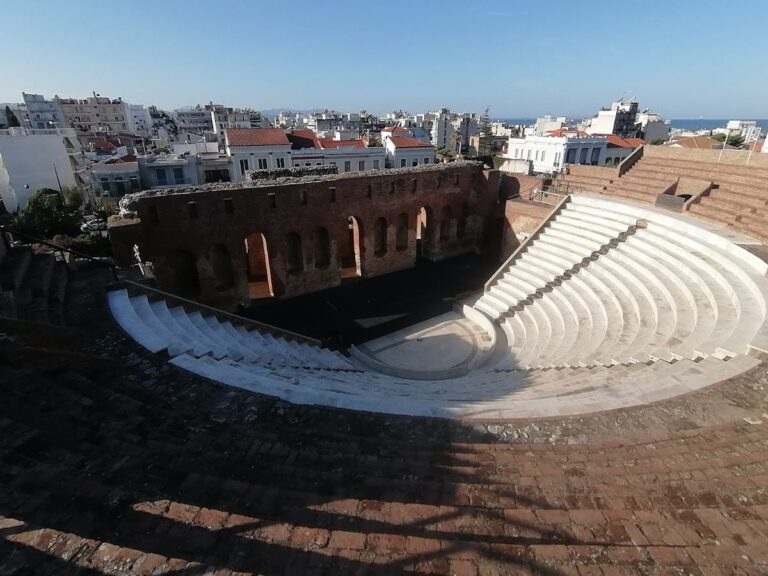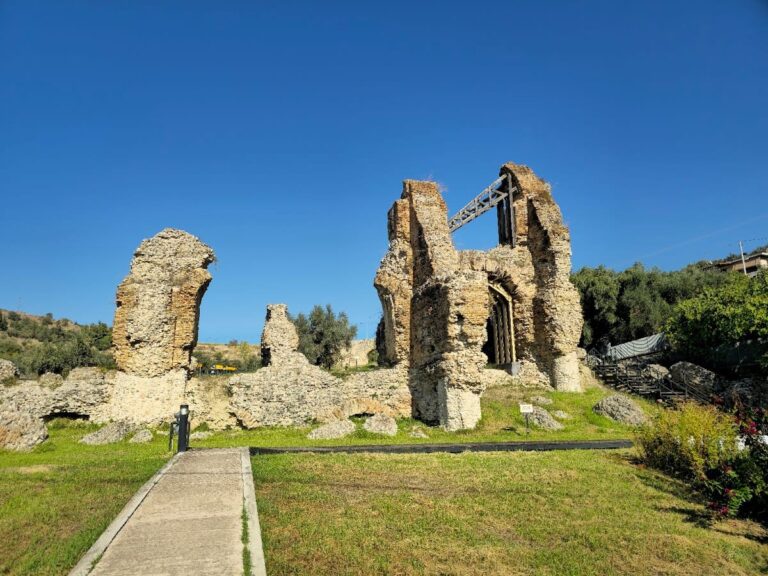Olympia: The Ancient Panhellenic Sanctuary and Birthplace of the Olympic Games
Table of Contents
Visitor Information
Google Rating: 4.7
Popularity: Low
Google Maps: View on Google Maps
Country: Greece
Civilization: Byzantine, Greek, Roman
Remains: Religious
Context
Olympia is situated in the fertile valley of the Alfeios River in the western Peloponnese, within the modern municipality of Ancient Olympia, Greece. The site occupies a low-lying alluvial plain adjacent to the river’s right bank, enclosed by gentle hills that create a natural amphitheater-like setting. This landscape provided abundant natural resources, including arable land and water, which supported continuous human activity from the Late Bronze Age onward.
Archaeological investigations have revealed that the area was a focal point for ritual and athletic activities from early periods, evolving into a major Panhellenic sanctuary. Over time, Olympia became synonymous with the Olympic Games, a religious and athletic festival of profound cultural significance.
Excavations initiated in the late 19th century have uncovered extensive stratigraphy, votive offerings, and inscriptions that document the site’s long history. Today, the remains are preserved within a protected archaeological park, recognized as a UNESCO World Heritage Site since 1989.
History
Olympia’s historical trajectory extends from the Late Bronze Age through Late Antiquity, reflecting its transformation from a localized cult site into a renowned religious and athletic center. Its development was closely intertwined with regional political dynamics, religious practices, and imperial patronage. The sanctuary’s prominence was anchored by the Olympic Games, which shaped its identity and influence across the Greek world and later the Roman Empire. The site’s decline in Late Antiquity resulted from a combination of imperial religious reforms, natural disasters, and socio-political changes.
Late Bronze Age and Early Iron Age (c. 13th–9th centuries BC)
Archaeological evidence from the Pelopion area within Olympia indicates continuous ritual activity beginning in the Late Bronze Age. Ceramic sequences, including submycenaean (1100–1000 BC) and protogeometric (1000–900 BC) wares, demonstrate sustained cultic use. Excavations have uncovered votive figurines, ritual vessels, and remains of food and burnt offerings dating to the 10th century BC, attesting to early religious practices. Although no architectural remains survive from this phase, these finds suggest the establishment of a sanctuary dedicated to Zeus by the 9th or 8th centuries BC, marking the site’s emergence as a significant sacred precinct in the Peloponnese.
Geometric and Archaic Periods (8th–6th centuries BC)
The 8th century BC witnessed the institutionalization of the Olympic festival, traditionally dated to 776 BC, under the jurisdiction of the city-state of Elis. This event inaugurated a four-year cycle of athletic contests that would become central to Olympia’s identity. Around 700 BC, the sanctuary underwent substantial modifications, including land leveling and the excavation of new wells, reflecting increased organization and infrastructure development. Control of the sanctuary shifted to the Pisatans in 676 BC, who administered the games until Elis, allied with Sparta, reasserted dominance by occupying Pisa in 580 BC.
Construction activity commenced circa 600 BC with the erection of the Temple of Hera by the Skiloudians, allies of the Pisatans. Throughout the 6th century BC, additional structures such as treasuries representing various city-states, the Pelopion tomb complex dedicated to the mythical King Pelops, the Bouleuterion (council house), and the first stadium were established. The stadium initially consisted of a simple track but was remodeled around 500 BC to include sloping spectator sides and was shifted eastward. The Olympic festival expanded its athletic program during this period, consolidating Olympia’s status as a Panhellenic religious and sporting center.
Classical Period (5th–4th centuries BC)
The Classical era represents the apogee of Olympia’s religious and athletic significance. The mid-5th century BC saw the construction of the monumental Temple of Zeus, distinguished by its grand scale and elaborate sculptural decoration, including the renowned chryselephantine statue of Zeus by Pheidias. This period also saw the development of the Greek Baths, the final iteration of the stadium, and the hippodrome for chariot racing. The Prytaneion, built in 470 BC, functioned as the sanctuary’s administrative center.
Later 4th-century BC additions included the Metroon near the treasuries, the Echo Stoa which acoustically separated the sanctuary from the stadium and games area, and the South Stoa along the sanctuary’s southern boundary. These constructions reflect sustained investment and the sanctuary’s continued prominence amid shifting political alliances in the Peloponnese during the late Classical period.
Hellenistic Period (4th–2nd centuries BC)
In the Hellenistic era, Olympia experienced further architectural expansion within the broader context of Macedonian influence following Alexander the Great’s conquests. The Philippeion, a circular memorial honoring Philip II of Macedon and his family, was erected in the late 4th century BC. Around 300 BC, the Leonidaion, the largest building on site, was constructed to accommodate distinguished visitors, indicating the sanctuary’s role in hosting elite guests.
Athletic infrastructure was enhanced with the addition of the Palaestra in the 3rd century BC and the Gymnasion in the 2nd century BC, supporting the professionalization of athletic training. Bathhouses dating to circa 300 BC replaced earlier Greek facilities. A vaulted archway connecting the stadium entrance to the sanctuary was built around 200 BC, facilitating ceremonial processions and access.
Roman Period (1st–4th centuries AD)
Under Roman dominion, the Olympic Games were opened to all citizens of the empire, significantly increasing the festival’s scale and prestige. The sanctuary underwent extensive restoration and new construction, including repairs to the Temple of Zeus. The Nympheum, a monumental fountain or exedra, was erected around 150 AD, and an aqueduct was constructed by 160 AD to improve water supply.
Roman baths replaced earlier Greek bathing facilities around 100 AD, reflecting Roman cultural practices. The 3rd century AD brought considerable challenges, including a major earthquake and invasions in 267 AD, which caused widespread damage. In response, the sanctuary was fortified using materials salvaged from damaged monuments. Despite these adversities, the Olympic festival persisted until 393 AD, when Emperor Theodosius I issued edicts prohibiting pagan rituals and contests.
Late Antiquity and Early Byzantine Period (4th–7th centuries AD)
Following the official suppression of pagan festivals, Olympia underwent a religious transformation. The Temple of Zeus was destroyed around 426 AD during imperial campaigns against paganism under Theodosius II. The workshop of the sculptor Pheidias was converted into a Christian basilica, and a Christian community established residence at the site. This shift reflects the broader Christianization of the empire and the decline of traditional cults.
Archaeological evidence indicates that small-scale, possibly clandestine Olympic events continued into the mid-6th century AD. However, repeated earthquakes, plague outbreaks, and flooding from the Alfeios River progressively undermined the settlement’s viability. By the early 7th century AD, the sanctuary and adjacent habitation were largely abandoned, marking the end of Olympia’s ancient religious and athletic functions.
Medieval to Modern Rediscovery
After centuries of burial beneath alluvial deposits, Olympia was rediscovered in the 18th century by antiquarians such as Richard Chandler. Early travelers documented visible ruins, and formal archaeological excavations commenced in the 19th century under French and subsequently German teams. These investigations revealed the sanctuary’s stratigraphy, inscriptions, and artifacts, establishing a detailed chronology and underscoring its historical significance.
Today, Olympia is preserved as a protected archaeological park and recognized as a UNESCO World Heritage Site. It continues to be a focal point for the study of ancient Greek religion, athletics, and art, as well as the symbolic origin of the modern Olympic Games.
Remains
Architectural Features
Olympia’s core is the Altis, an irregular quadrangular sacred precinct measuring over 183 meters on each side. Enclosed by a wall on all sides except the north—where Mount Kronos (Kronion) forms a natural boundary—the Altis contained a sacred grove with trees such as olive, plane, Judas-tree, and Aleppo pine, some of which survive today. The precinct’s boundaries evolved over time, with the original stadium extending into what later became the eastern wall. The enclosing wall dates to no later than the 5th century BC, contemporary with the poet Pindar.
The site’s layout reflects its primarily religious and athletic character, with a concentration of temples, altars, and sporting facilities. Construction materials include local stone and terracotta roof tiles. The sanctuary expanded gradually from the Late Bronze Age through the Classical and Hellenistic periods, with later Roman additions and fortifications. Many structures survive as ruins, some partially restored, while others remain fragmentary or visible only as foundations.
Key Buildings and Structures
Temple of Zeus
Constructed in the mid-5th century BC, the Temple of Zeus was the largest and most ornate building at Olympia. Built of ashlar masonry, it housed the colossal chryselephantine statue of Zeus by Pheidias, made of ivory and gold on a wooden frame, considered one of the Seven Wonders of the Ancient World. The temple featured elaborate sculptural decoration and underwent repairs during the 2nd century AD under Roman rule. It was destroyed around 426 AD during the Christian suppression of paganism. Its foundations and partial wall remains were identified during the 1829 French excavations and have been extensively studied since.
Temple of Hera
Dating to circa 600 BC, the Temple of Hera is one of the oldest surviving temples at Olympia. Built by the Skiloudians, allies of the Pisatans, it is a peripteral Doric temple constructed of local limestone with terracotta roofing. The remains include foundation walls, column fragments, and stylobate. Located within the Altis precinct, it served as a focal point for ritual activity and is the traditional site for the modern Olympic flame lighting ceremony, where sunlight is reflected by a parabolic mirror.
Pelopion
The Pelopion is a tomb and sanctuary dedicated to the mythical King Pelops, enclosed by a peribolos wall dating to the 6th century BC that remodeled an earlier sanctuary. Excavations have revealed continuous ceramic sequences from the 11th century BC onward, including submycenaean and protogeometric periods. Cultic materials such as votive figurines and pottery have been recovered. The remains include foundation walls and altar areas within the Altis precinct, underscoring the site’s legendary and religious significance.
Stadium
The stadium dates to the 8th century BC, with major games held from the 720s BC. Originally a simple field marked by start and finish lines with transverse curbing, it was remodeled around 500 BC to include sloping spectator sides and was shifted slightly eastward. The final Classical period stadium features a vaulted archway entrance corridor built circa 200 BC, linking it to the sanctuary. The seating areas survive as sloping earthworks, and the track’s layout remains visible. The stadium’s length established the standard ancient Greek unit of distance, the stadion. The stadium has been used for modern Olympic events without altering the ancient topography.
Hippodrome
Located east of the Echo Stoa and the stadium, the hippodrome was constructed during the Classical period for chariot racing. Its remains are fragmentary, consisting of earthworks and foundation traces. The hippodrome lies beyond the main sanctuary precinct and is associated with the athletic contests held at Olympia.
Prytaneion
Built in 470 BC on the northwest side of the sanctuary, the Prytaneion served as an administrative and civic building. Its remains include foundation walls and partial masonry. The structure’s layout suggests rooms for official functions and hospitality related to the sanctuary’s activities.
Philippeion
Erected in the late 4th century BC north of the sanctuary near the Prytaneion and treasuries, the Philippeion is a circular memorial building. Its foundations and column bases survive, indicating a peristyle of Ionic columns surrounding a central cella. The structure was built in honor of Philip II of Macedon and his family.
Treasuries
A group of small buildings constructed in the 6th century BC, the treasuries represented various Greek city-states. Located north of the sanctuary near the Prytaneion and Philippeion, their remains include foundation outlines and partial wall fragments. These buildings stored votive offerings and dedications.
Metroon
Constructed around 400 BC near the treasuries, the Metroon served a religious or civic function. Its remains consist of foundation walls and partial masonry. The building’s precise layout and use remain partially unclear but it is associated with the sanctuary complex.
Echo Stoa
Built circa 350 BC east of the treasuries, the Echo Stoa separated the sanctuary from the stadium and games area. Its remains include foundation walls and column bases. The stoa’s name derives from its acoustic properties, with echoes audible within the covered colonnade.
South Stoa
Constructed around 350 BC along the southern edge of the sanctuary, the South Stoa’s remains include foundation walls and column fragments. It formed a covered walkway or gathering space within the sanctuary precinct.
Bouleuterion
Built in the 6th century BC south of the sanctuary, the Bouleuterion functioned as a council or assembly building. Its remains include foundation walls and partial masonry. The structure’s layout suggests a meeting hall with seating arrangements.
Palaestra
Constructed in the 3rd century BC, the Palaestra served as an athletic training facility. Its remains include foundation walls outlining a central courtyard surrounded by colonnades. The building’s design accommodated wrestling and other physical exercises.
Gymnasion
Built in the 2nd century BC, the Gymnasion was used for athletic training. Its remains consist of foundation walls and partial masonry. The structure likely included open spaces and covered areas for physical preparation.
Leonidaion
Constructed around 300 BC, the Leonidaion is the largest building on site and served as lodging for distinguished visitors. Its remains include foundation walls, column bases, and partial masonry. The building’s layout features a central courtyard surrounded by rooms.
Greek Baths
Dating to the Classical period, the Greek Baths were replaced around 100 AD by Roman baths. The remains include foundation walls and fragments of bathing rooms. The structure’s layout accommodated bathing and related activities.
Roman Baths
Built circa 100 AD, the Roman Baths replaced the earlier Greek facilities. Their remains include hypocaust (underfloor heating) systems, foundation walls, and bathing chambers. The baths reflect Roman architectural and engineering techniques.
Nympheum (Exedra)
Constructed around 150 AD, the Nympheum is a monumental fountain or exedra. Its remains include foundation walls and decorative elements. The structure was part of the Roman water supply and ornamental system within the sanctuary.
Aqueduct
Built circa 160 AD, the aqueduct supplied water to Olympia. Remains include sections of the water channel and supporting structures. The aqueduct improved the site’s water management during the Roman period.
Workshop of Pheidias
Located near the Temple of Zeus, the workshop was excavated in the 1950s. Archaeological finds include sculptor’s tools confirming its function as Pheidias’ studio. Following the decline of pagan worship, the building was converted into a Christian basilica. Remains include foundation walls and partial masonry.
City Walls and Fortifications
The Altis precinct was walled except to the north. In the 3rd century AD, following earthquake damage and invasions, the sanctuary’s center was fortified using materials salvaged from damaged monuments. Remains include sections of defensive walls and reused architectural fragments.
Other Remains
Over 760 significant buildings once existed at Olympia, with many ruins surviving as foundations, walls, and scattered architectural fragments. These include numerous treasuries, altars, statues, and smaller shrines dedicated to various deities. The sanctuary extended beyond the boundary wall, especially in areas related to the games. The Kladeos River forms the western border, and the Alfeios River lies to the south. The ancient village of Olympia is believed to be located at the modern village site, which has been continuously inhabited since antiquity.
Archaeological Discoveries
Excavations at Olympia have uncovered a wide range of artifacts spanning from the Late Bronze Age through Late Antiquity. Pottery includes submycenaean, protogeometric, Geometric, Classical, Hellenistic, and Roman examples, found in sanctuaries, domestic areas, and burial contexts. Votive figurines and ritual vessels have been recovered, particularly from the Pelopion and Altis precinct.
Inscriptions document imperial benefactions, dedications, and imperial edicts, including those that ended pagan contests in the late 4th century AD. Coins from various Greek city-states and Roman emperors have been found, reflecting the site’s long occupation and connections.
Tools related to sculpture, including those from the workshop of Pheidias, have been discovered, confirming artistic activity. Domestic objects such as lamps and cooking vessels appear in settlement layers. Religious artifacts include statuettes, altars, and ritual vessels, many associated with Zeus and the Olympian gods.
Notably, a 2,500-year-old unbroken bronze bull idol was found near the Temple of Zeus in 2021, alongside fine Geometric period pottery. Ceramic debris, bronze and ceramic objects, and terracotta roof tiles have been recovered throughout the site, contributing to the understanding of construction and ritual practices.
Preservation and Current Status
Many of Olympia’s major structures survive as conserved ruins, with foundations, walls, and architectural fragments visible. The Temple of Zeus and Temple of Hera remain as partial ruins, with some restoration work stabilizing their remains. The stadium’s earthworks and vaulted archway entrance are preserved without modern alteration to the ancient topography.
Roman baths and the Nympheum survive in fragmentary condition, with hypocaust systems partially exposed. The workshop of Pheidias is preserved as foundation remains. Fortification walls from the 3rd century AD survive in sections, showing reuse of earlier materials.
Excavations and conservation have been ongoing since the 19th century, primarily under the German Archaeological Institute. Many areas are stabilized but not fully restored, preserving the original archaeological fabric.

